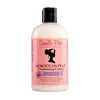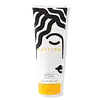What's inside
What's inside
 Key Ingredients
Key Ingredients

No key ingredients
 Benefits
Benefits

 Concerns
Concerns

 Ingredients Side-by-side
Ingredients Side-by-side

Water
Skin ConditioningOpuntia Ficus-Indica Seed Oil
EmollientPrunus Armeniaca Kernel Oil
MaskingUrtica Dioica Extract
AstringentCocos Nucifera Oil
MaskingAloe Barbadensis Leaf Juice
Skin ConditioningSimmondsia Chinensis Seed Oil
EmollientGlycerin
HumectantCetearyl Alcohol
EmollientRosa Canina Fruit Oil
EmollientEquisetum Arvense Extract
AstringentBehentrimonium Methosulfate
Olus Oil
EmollientAlmondeth-20
EmulsifyingTheobroma Cacao Seed Butter
EmollientPhenoxyethanol
PreservativeCitric Acid
BufferingWater, Opuntia Ficus-Indica Seed Oil, Prunus Armeniaca Kernel Oil, Urtica Dioica Extract, Cocos Nucifera Oil, Aloe Barbadensis Leaf Juice, Simmondsia Chinensis Seed Oil, Glycerin, Cetearyl Alcohol, Rosa Canina Fruit Oil, Equisetum Arvense Extract, Behentrimonium Methosulfate, Olus Oil, Almondeth-20, Theobroma Cacao Seed Butter, Phenoxyethanol, Citric Acid
Water
Skin ConditioningCetearyl Alcohol
EmollientGlycol Distearate
EmollientSteartrimonium Chloride
PreservativeCocoglucosides Hydroxypropyltrimonium Chloride
CleansingSimmondsia Chinensis Seed Oil
EmollientRicinus Communis Seed Oil
MaskingPersea Gratissima Oil
Skin ConditioningOlea Europaea Fruit Oil
MaskingMelaleuca Alternifolia Leaf Oil
AntioxidantMel
EmollientCocos Nucifera Oil
MaskingArgania Spinosa Kernel Oil
EmollientPrunus Amygdalus Dulcis Oil
Skin ConditioningButyrospermum Parkii Oil
EmollientPanthenol
Skin ConditioningBiotin
AntiseborrhoeicCopernicia Cerifera Wax
Hydrolyzed Vegetable Protein Pg-Propyl Silanetriol
Skin ConditioningAcetic Acid
BufferingAloe Barbadensis Leaf Juice
Skin ConditioningTocopherol
AntioxidantEthylhexylglycerin
Skin ConditioningTrideceth-3
EmulsifyingTrideceth-15
EmulsifyingPolyquaternium-37
Propylene Glycol Dicaprylate/Dicaprate
EmollientPPG-1 Trideceth-6
Skin ConditioningCetrimonium Chloride
AntimicrobialCitric Acid
BufferingPhenoxyethanol
PreservativeAmodimethicone
Isopropyl Alcohol
SolventParfum
MaskingAlcohol
AntimicrobialPotassium Sorbate
PreservativeDisodium EDTA
Benzyl Benzoate
AntimicrobialWater, Cetearyl Alcohol, Glycol Distearate, Steartrimonium Chloride, Cocoglucosides Hydroxypropyltrimonium Chloride, Simmondsia Chinensis Seed Oil, Ricinus Communis Seed Oil, Persea Gratissima Oil, Olea Europaea Fruit Oil, Melaleuca Alternifolia Leaf Oil, Mel, Cocos Nucifera Oil, Argania Spinosa Kernel Oil, Prunus Amygdalus Dulcis Oil, Butyrospermum Parkii Oil, Panthenol, Biotin, Copernicia Cerifera Wax, Hydrolyzed Vegetable Protein Pg-Propyl Silanetriol, Acetic Acid, Aloe Barbadensis Leaf Juice, Tocopherol, Ethylhexylglycerin, Trideceth-3, Trideceth-15, Polyquaternium-37, Propylene Glycol Dicaprylate/Dicaprate, PPG-1 Trideceth-6, Cetrimonium Chloride, Citric Acid, Phenoxyethanol, Amodimethicone, Isopropyl Alcohol, Parfum, Alcohol, Potassium Sorbate, Disodium EDTA, Benzyl Benzoate
Ingredients Explained
These ingredients are found in both products.
Ingredients higher up in an ingredient list are typically present in a larger amount.
Aloe Barbadensis Leaf Juice comes from leaves of the aloe plant. Aloe Barbadensis Leaf Juice is best known for helping to soothe sunburns. It is also anti-inflammatory, moisturizing, antiseptic, and can help heal wounds.
Aloe is packed with good stuff including Vitamins A, C, and E. These vitamins are antioxidants, which help fight free-radicals and the damage they may cause. Free-radicals are molecules that may damage your skin cells, such as pollution.
Aloe Barbadensis Leaf Juice also contains sugars. These sugars come in the form of monosaccharides and polysaccharides, folic acid, and choline. These sugars are able to help bind moisture to skin.
It also contains minerals such as calcium, 12 anthraquinones, fatty acids, amino acids, and Vitamin B12.
Learn more about Aloe Barbadensis Leaf JuiceCetearyl alcohol is a mixture of two fatty alcohols: cetyl alcohol and stearyl alcohol. It is mainly used as an emulsifier. Emulsifiers help prevent the separation of oils and products. Due to its composition, it can also be used to thicken a product or help create foam.
Cetearyl alcohol is an emollient. Emollients help soothe and hydrate the skin by trapping moisture.
Studies show Cetearyl alcohol is non-toxic and non-irritating. The FDA allows products labeled "alcohol-free" to have fatty alcohols.
This ingredient is usually derived from plant oils such as palm, vegetable, or coconut oils. There is debate on whether this ingredient will cause acne.
Due to the fatty acid base, this ingredient may not be Malassezia folliculitis safe.
Learn more about Cetearyl AlcoholCitric Acid is an alpha hydroxy acid (AHA) naturally found in citrus fruits like oranges, lemons, and limes.
Like other AHAs, citric acid can exfoliate skin by breaking down the bonds that hold dead skin cells together. This helps reveal smoother and brighter skin underneath.
However, this exfoliating effect only happens at high concentrations (20%) which can be hard to find in cosmetic products.
Due to this, citric acid is usually included in small amounts as a pH adjuster. This helps keep products slightly more acidic and compatible with skin's natural pH.
In skincare formulas, citric acid can:
While it can provide some skin benefits, research shows lactic acid and glycolic acid are generally more effective and less irritating exfoliants.
Most citric acid used in skincare today is made by fermenting sugars (usually from molasses). This synthetic version is identical to the natural citrus form but easier to stabilize and use in formulations.
Read more about some other popular AHA's here:
Learn more about Citric AcidCocos Nucifera Oil is obtained from the kernels of the coconut fruit. In other words, this is coconut oil.
Coconut Oil is rich in fatty acids with lauric acid making up the majority of these. It also contains linoleic acid. Due to this high fatty acid content, coconut oil helps trap moisture and soften skin.
Despite being antibacterial, coconut oil may not be great for acne-prone skin. It is comedogenic and may clog pores. This ingredient may not be safe for malassezia or fungal acne.
Note: Coconut Oil should not replace your sunscreen for UV protection. Studies show it only blocks about 20% of UV.
This oil is non-volatile and has a light scent.
The term 'fragrance' is not regulated in many countries. In many cases, it is up to the brand to define this term. For instance, many brands choose to label themselves as "fragrance-free" because they are not using synthetic fragrances. However, their products may still contain ingredients such as essential oils that are considered a fragrance.
Learn more about Cocos Nucifera OilPhenoxyethanol is a preservative that has germicide, antimicrobial, and aromatic properties. Studies show that phenoxyethanol can prevent microbial growth. By itself, it has a scent that is similar to that of a rose.
It's often used in formulations along with Caprylyl Glycol to preserve the shelf life of products.
This oil comes from the seeds of the desert shrub called Jojoba. It is more commonly known as jojoba oil, a non-comedogenic oil.
Jojoba oil does not contain fragrance and has many fatty-acids, making it a great soothing ingredient.
It also contains Vitamin E, a great moisturizing ingredient. Vitamin E is also an antioxidant and protects your skin against oxidative damage.
This ingredient humectant properties, meaning it helps draw moisture from the air. This helps keep your skin hydrated.
While jojoba has antibacterial properties, it is only able to kill some strains of bacteria.
Studies also show it helps in wound healing. In fact, Indigenous cultures have used jojoba as a moisturizer and to help treat burns for centuries.
Fun fact: Jojoba oil similar to natural human skin sebum, so it has a great effect on dry skin. It is also promising with helping to regulate sebum production.
Due to its fatty acid content, Jojoba oil may not be fungal acne safe. We recommend speaking with a professional if you have any concerns.
Learn more about Simmondsia Chinensis Seed OilWater. It's the most common cosmetic ingredient of all. You'll usually see it at the top of ingredient lists, meaning that it makes up the largest part of the product.
So why is it so popular? Water most often acts as a solvent - this means that it helps dissolve other ingredients into the formulation.
You'll also recognize water as that liquid we all need to stay alive. If you see this, drink a glass of water. Stay hydrated!
Learn more about Water